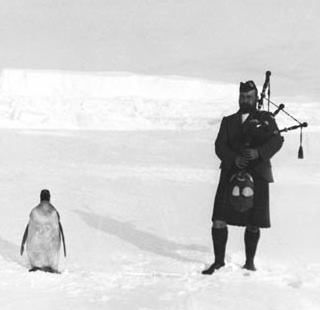
The Scots in Antarctica
At the turn of the 19th century William Speirs Bruce, a Scotsman, was probably Britain’s most experienced polar scientist.
He applied to join Scott’s Discovery Expedition and made a proposal to add a second ship to study the Weddell Sea but the Royal Geographical Society (RGS) president Sir Clements Markham (who appears to have been something of a douchebag) dismissed his proposal.
Bruce then decided to run his own expedition and secured private funding, especially from the wealthy Coats family. The Scottish National Antarctic Expedition was born.
Bruce intended to go as far south as possible and set up a Winter station to do deep sea and other research of the Antarctic Ocean, as well as conduct meteorology, geology, biology, topography and terrestrial physics.
It was probably the best planned and cost-effective expedition of the age , totally composed of Scots in a specially fitted ship, the Scotia.
Bruce encountered sea ice and was forced to set up his winter station on Laurie Island in the South Orkney Island group.
While their ship, Scotia, allowed itself to be trapped in the ice 400 m from shore and converted to winter quarters, the scientists built a hut on the island out of local stone which came to be known as Ormond House. Here they conducted meteorological readings.

When the ice thawed Bruce took the Scotia to Argentina to offer the Argentinian government the transfer of Ormond House as a meteorological base for the sum of 5000 pesos, which, after much discussion, they accepted.
The Scotia sailed back to Laurie Island carrying Argentinean officials to take ownership of Ormond House and the establishment of a permanent base on the South Orkney Islands.
Bruce continued south in the Scotia and discovered the far edge of the Weddell Sea and the area of Antarctica which he named Coats Land, after his benefactors.
On his return to Scotland, Bruce was presented with the Royal Scottish Geographical Society’s Gold Medal. The expedition had discovered 212 animal species previously unknown, and contributed greatly to many fields of science.
The expedition had conducted a more comprehensive programme than that of any previous or contemporary Antarctic expedition of the time.
Markham, the head of the Royal Geographical Society in England, ignored and dismissed the achievements of the expedition, and under his leadership refused to award Bruce and his men the prestigious Polar Medal.
Bruce was in good company as Amundsen had also been denied the medal before him.
In 1906 Bruce would commission his own silver medal, which he awarded to scientific and crew members of the expedition.
Their achievements are mainly forgotten now but the Scots did a stirling job. Ormond House is now an Argentinian scientific base known as Base Orcadas and it is the first permanently inhabited base in the Antarctic region and has been permanently occupied since 1904.
